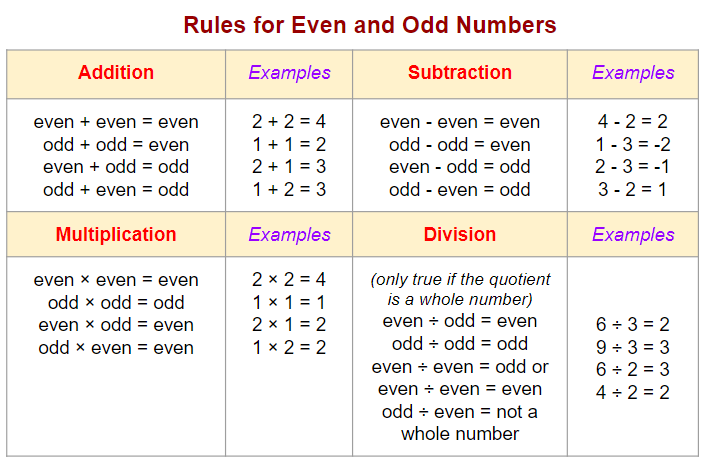Rules for Even and Odd Numbers
Are they any patterns or rules when adding, subtracting, multiplying or dividing even and odd numbers?
The following diagrams show some rules and examples when adding, subtracting, multiplying, or dividing even and odd numbers. The rules for division is only true if the quotient is a whole number. Scroll down the page for more examples and explanations.

What are even numbers?
- A number that ends in a 0, 2, 4, 6 or 8.
- A number that is divisible by 2.
- A number that is a multiple of 2.
What are odd numbers?
- A number that ends in 1, 3, 5, 7 or 9.
- A number that is not divisible by 2.
- A number that is not a multiple of 2.
Using the properties of odd and even numbers - Addition
- Use addition with pairs of odd or even numbers or one odd and one even number.
- Use understanding of this relationship to check the accuracy of calculations.
Sum of two even numbers is always even. (even + even = even)
Sum of two odd numbers is always even. (odd + odd = even)
Sum of an even and odd number is odd. (even + odd = odd or odd + even = odd)
Using the properties of odd and even numbers - Subtraction
- Use subtraction with pairs of odd or even numbers or one odd and one even number.
- Use understanding of this relationship to check the accuracy of calculations.
When both numbers are even, the difference of the numbers is even. (even - even = even)
When both numbers are odd, the difference of the numbers is even. (odd - odd = even)
When one number is even and the other odd, the difference of the numbers is odd. (even - odd = odd or odd - even = odd)
Using the properties of odd and even numbers - Multiplication
- Use multiplication with pairs of odd or even numbers or one odd and one even number.
- Use understanding of this relationship to check the accuracy of calculations.
When both numbers are even, the product of the numbers is even. (even × even = even)
When both numbers are odd, the product of the numbers is odd. (odd × odd = odd)
When one number is even and the other odd, the product of the numbers is even. (even × odd = even or odd × even = even)
Using the properties of odd and even numbers - Division
- Use multiplication with pairs of odd or even numbers or one odd and one even number.
- Use understanding of this relationship to check the accuracy of calculations.
The following rules for division is only true if the quotient is a whole number.
even ÷ odd = even
odd ÷ odd = even
even ÷ even = odd or even
odd ÷ even = not a whole number
Try out our new and fun Fraction Concoction Game.
Add and subtract fractions to make exciting fraction concoctions following a recipe. There are four levels of difficulty: Easy, medium, hard and insane. Practice the basics of fraction addition and subtraction or challenge yourself with the insane level.

We welcome your feedback, comments and questions about this site or page. Please submit your feedback or enquiries via our Feedback page.